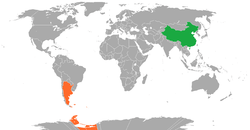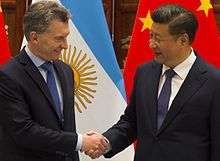Argentina–China relations
 | |
China |
Argentina |
|---|---|

Argentine-Chinese relations are foreign relations between Argentine Republic and People's Republic of China. Both countries established diplomatic relations on March 19, 1972. Until then Argentina only recognized the Republic of China.
Argentina has an embassy in Beijing and 2 Consulates-General in Hong Kong and Shanghai. China has an embassy in Buenos Aires.
In March 2016, the Argentine Coast Guard sank a Chinese fishing vessel which entered Argentine waters illegally. No casualties or injuries were reported.[1]
Brief History of China-Latin America Relations
China’s Zhou Enlai, during Mao Zedong’s leadership, steered the initial China-Latin America relations by encouraging friendly connections that eventually led to diplomatic relations. The development of diplomatic relations of China and Latin America was in the interest of developing cultural and economic ties.[2] Organizations without ties to the governments of Latin American countries were created to help strengthen these ties between China and Latin America.[2] Starting from 1970, until 1974, China successfully developed diplomatic relations with 12 of Latin America’s countries. Five of them in the early part of the four-year span being Argentina, Brazil, Chile, Mexico, and Venezuela. Five more Latin American countries were recognized as foreign constituents of China in the later years of the 1980s.[3] For China and Latin America to expand on their diplomatic relations, China generated four interrelated concepts – “peace, mutual support, mutual benefit, and collaborative development."[3] One of Argentina's main export is soybeans and soybean related products. The Argentinian government in 2002 led by Eduardo Duhalde enforced high taxes of soybean exports, and Néstor Kirchner's following administration doubled that amount.[4] In November 2004, Kirchner went to Beijing to address China and Argentina's cooperation in future investments and exchanges.[5]
Trade between China and Argentina
Two factors on economic influence within Argentina is China's emigration, and exports and imports. Approximately 64% of the farmable land in Argentina is reserved for soybean production.[6] Since 2010, Argentina has become a main exporter of soybean meal and soybean oil. The soybean meal and soybean oil percentages of Argentina range from over 40% (soybean meal) and 60% (soybean oil) of global production. In order to grow Argentina's collective income, soybeans (and soybean related items) are charged 35% of their worth; the greater part of these profits are 5% of Argentina's collective income in soybean exportation.[6] Argentina's financial sector has experienced changes within their soybean exports since the early 2000s.[7] With China’s influence in Latin America during this early period, countries a part of the Mercosur organization also experienced changes within their trade evaluations.[8] The rate of soybean production of five South American countries a part of Mercosur witnessed a 221.4% growth from 1995 to 2010. Argentina is one of China's main trading partners in South America; the trade between both countries amounting to nearly $13 billion in US currency. Before 2008, the amount of exports Argentina sent to China accounted to be US $5.796 billion, and the imports from China to Argentina totaled to be US $7.649 billion.[6] The trade exchange between Argentina and China showed an 80% export of soybean products to China from Argentina, and Chinese industrial exports totaling to be 98.9% of Argentina's imports.
During the economic crisis of 2008, with the minor loss in profits in imports and exports worldwide, and China managing to maintain consistency economically, China was recognized as a world power which directly effected the relationship with Argentina.[9] In 2008, when Argentinian trades to China reached US $6,379 million, the exports of soybean products to China from Argentina stopped. Already processed soybean products were prohibited in the Chinese market due to China's own competitive soybean crushing industry.[10] Argentina's total investment in soybean exports was US $143 million in the past two decades and increased to US $5.55 billion.[10] This event led to Argentina's bilateral trade deficit from 2007 to 2014 amounting to US $24,164 million.[11] During these two decades, Argentina's economic strategies have been ideal to soybean production which expanded from 1995's, 12 million tons, to 2010's, 52.6 million tons.[12] During Argentina's trade deficit, not all of Argentina's soybean products were exported to China, leading to a growth in Argentina's trading partners. In 2012, India was an important importer of Argentine soy oil, followed by China, some European countries, Iran, and Peru.[4] In 2013, Argentina was ranked third in global soybean production, after Brazil and the United States. The amount of soybean production within Argentina totaled to be 18% worldwide.[13]
When trade between China and Argentina increased after the initial deficit, China started to direct their attention towards Argentina's local markets, and infrastructures. China invested in large projects in Argentina such as roads, railroads, and shipping ports to increase export profitability to China.[11] Chinese interest in Argentina has been focused on areas of manufacturing connected to exports to China such as oil, railroads to transport products across different areas of the country, and the soybean industry.[14] In 2010, Chinese investments influenced the Economic Commission for Latin America which largely influenced the economy in Argentina.[11] One of China's influences has been through supplying industrial items to Argentina's growing economy such as: cellular, radio, and television equipment, and computer mainframes.[5]
Chinese Involvement in Migration and Land Investments
Residency
In 2010 Argentina's National Census listed 11,804 Chinese immigrants living within its borders - 75.6% of this number were immigrants from the People's Republic of China.[15] Foreign immigrants are allowed to stay in the country as either "permanent residents", refugees, or "temporary" residents due to the 2004 Argentinian Migration Act.[15] The National Directorate of Migration (NDM) confirmed that 17,505 Chinese citizens had their permanent residency requests approved between 2004 and 2013.[15] After this period, the NDM published their completed analysis/study in 2014 concerning the 2003–2013 census of Chinese residents to show that 48.8% of Chinese immigrants had violated Argentine laws at one point during this time period.[15] This statistic represents a relatively small number of Chinese immigrants actually within the prison system - specifically the 19 Chinese immigrants out of 2,259 foreigners inside the Argentinian prison system.[15] Crimes committed against the Chinese citizens of Argentina remained unresolved. The Argentinian government submitted requests during this time to China's Ministry of Public Security for help with solving and reducing the number of repeat cases.[16] After the first initial visit from the Chinese police delegation of December 2011, homicides continued, and Argentina and China together decided to resume the cooperation agreement of 1997 in order to solve homicide cases and crimes related to human and drug trafficking.[17]
Both the Chinese government and the Argentinian government regulate the migration communication and flow through administrative decisions.[18] Illegal immigration in 2004 was addressed by the Argentinian government's Decree No. 1169 that insisted on regulating the migration of people from countries not a part of Mercosur.[18]
An impact of the Chinese community within Argentina's society and government has spread through the creation of organizations assembled by citizens, and establishment of offices representing Chinese companies within the last ten years.[19] Chinese community organizations and groups within Argentina aim to improve education and advancement of media, as well as provide space for incoming offices of Chinese corporations.[19]
Land Investment
Chinese ventures have focused on governing parcels of open land in Argentina for resources and food production wholly aimed towards Chinese purchase.[11][20][21] Neoliberal reforms endorsed by Latin American countries recognize foreign investments as being equal to domestic investment.[22] After the Chinese globalization program of 1999 - "Going Global" - aimed at expanding capital for the Chinese government on a global scale, Chinese corporations such as China International Water and Electric Corporation started to focus on garnering land in Latin America in 2000.[20] During discussion of global expanse within Argentina, it was determined that Argentinian land being invested in by Chinese companies would not officially be considered Chinese land, however China would have control over the production of resources within the area.[23] As of 2015, Chinese land investment discussions have stopped due to differences in views.[23]
Space
In November 2012, China signed an agreement to establish a satellite tracking facility near Las Lajas, Neuquén, operated by the China Satellite Launch and Tracking Control General.[24] Per Argentinian ambassador to China, Diego Guelar, China has agreed to use the base only for civilian purposes.[24]
See also
| Wikimedia Commons has media related to Relations of Argentina and the People's Republic of China. |
Bibliography
- Cardenal, Juan Pablo; Araújo, Heriberto (2011). La silenciosa conquista china (in Spanish). Barcelona: Crítica. pp. 92–94, 177–183.
- He, Shuangrong (2012). China-Latin America Relations: Review and Analysis. China: Social Sciences Academic Press. p. 2-3.
- Laufer, Rubén (June 2013). "Argentina-China: New Courses for an Old Dependency". Latin American Policy. 4: 124-130.
- O'Connor, Ernesto A (October 2013). "China, Brazil and Argentina: Agricultural Trade and Development?". American Journal of Chinese Studies. 20: 244-260.
- Oviedo, Eduardo (September 2015). "Argentina and China: An Analysis of the Actors in the Soybean Trade and the Migratory Flow". Journal of Chinese Political Science. 20: 244-260.
- Puyana, Alicia; Costantino, Agostina (November 2015). "Chinese Land Grabbing in Argentina and Colombia". Latin American Perspectives. 42: 109-114.
References
- ↑ https://www.yahoo.com/news/argentine-coast-guard-sinks-chinese-fishing-boat-202047682.html
- 1 2 He, Shuangrong (2012). China-Latin America Relations: Review and Analysis. China: Social Sciences Academic Press (China). p. 2. ISBN 9781844641123.
- 1 2 He, Shuangrong (2012). China-Latin America Relations: Review and Analysis. China: Social Sciences Academic Press (China). p. 3. ISBN 9781844641123.
- 1 2 Oviedo, Eduardo (September 2015). "Argentina and China: An Analysis of the Actors in the Soybean Trade and the Migratory Flow". Journal of Chinese Political Science. 20: 247 – via Galileo.
- 1 2 Laufer, Rubén (June 2013). "Argentina-China: New Courses for an Old Dependency". Latin American Policy. 4: 127 – via Galileo.
- 1 2 3 Laufer, Rubén (June 2013). "Argentina-China: New Courses for an Old Dependency". Latin American Policy. 4: 126 – via Galileo.
- ↑ Oviedo, Eduardo (September 2015). "Argentina and China: An Analysis of the Actors in the Soybean Trade and the Migratory Flow". Journal of Chinese Political Science. 20: 244 – via Galileo.
- ↑ O'Connor, Ernesto A. (October 2013). "China, Brazil and Argentina: Agricultural Trade and Development?". American Journal of Chinese Studies. 20: 99 – via Galileo.
- ↑ Laufer, Rubén (June 2013). "Argentina-China: New Courses for an Old Dependency". Latin American Policy. 4: 125 – via Galileo.
- 1 2 Oviedo, Eduardo (September 2015). "Argentina and China: An Analysis of the Actors in the Soybean Trade and the Migratory Flow". Journal of Chinese Political Science. 20: 245–247 – via Galileo.
- 1 2 3 4 Laufer, Rubén (June 2013). "Argentina-China: New Courses for an Old Dependency". Latin American Policy. 4: 124 – via Galileo.
- ↑ O'Connor, Ernesto A. (October 2013). "China, Brazil and Argentina: Agricultural Trade and Development". American Journal of Chinese Studies. 20: 104–105 – via Galileo.
- ↑ Oviedo, Eduardo (September 2015). "Argentina and China: An Analysis of the Actors in the Soybean Trade and the Migratory Flow". Journal of Chinese Political Science. 20: 245 – via Galileo.
- ↑ Laufer, Rubén (June 2013). "Argentina-China: New Courses for an Old Dependency". Latin American Policy. 4: 130 – via Galileo.
- 1 2 3 4 5 Oviedo, Eduardo (September 2015). "Argentina and China: An Analysis of the Actors in the Soybean Trade and the Migratory Flow". Journal of Chinese Political Science. 20: 254 – via Galileo.
- ↑ Oviedo, Eduardo (September 2015). "Argentina and China: An Analysis of the Actors in the Soybean Trade and the Migratory Flow". Journal of Chinese Political Science. 20: 254–255 – via Galileo.
- ↑ Oviedo, Eduardo (September 2015). "Argentina and China: An Analysis of the Actors in the Soybean Trade and the Migratory Flow". Journal of Chinese Political Science. 20: 255 – via Galileo.
- 1 2 Oviedo, Eduardo (September 2015). "Argentina and China: An Analysis of the Actors in the Soybean Trade and the Migratory Flow". Journal of Chinese Political Science. 20: 255–256 – via Galileo.
- 1 2 Oviedo, Eduardo (September 2015). "Argentina and China: An Analysis of the Actors in the Soybean Trade and the Migratory Flow". Journal of Chinese Political Science. 20: 260 – via Galileo.
- 1 2 Puyana, Alicia; Costantino, Agostina (November 2015). "Chinese Land Grabbing in Argentina and Colombia". Latin American Perspectives. 42: 109 – via Galileo.
- ↑ Puyana, Alicia; Costantino, Agostina (November 2015). "Chinese Land Grabbing in Argentina and Colombia". Latin American Perspectives. 42: 113 – via Galileo.
- ↑ Puyana, Alicia; Costantino, Agostina (November 2015). "Chinese Land Grabbing in Argentina and Colombia". Latin American Perspectives. 42: 110 – via Galileo.
- 1 2 Puyana, Alicia; Costantino, Agostina (November 2015). "Chinese Land Grabbing in Argentina and Colombia". Latin American Perspectives. 42: 114 – via Galileo.
- 1 2 Londoño, Ernesto (July 28, 2019). "From a Space Station in Argentina, China Expands Its Reach in Latin America". The New York Times.

.svg.png)